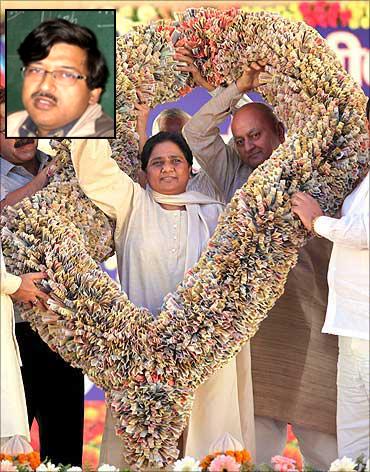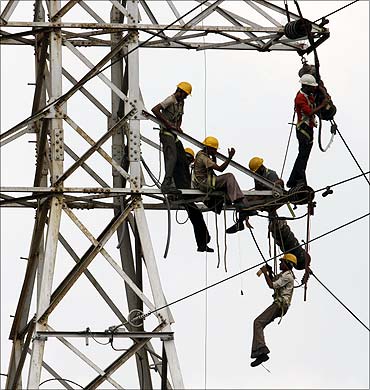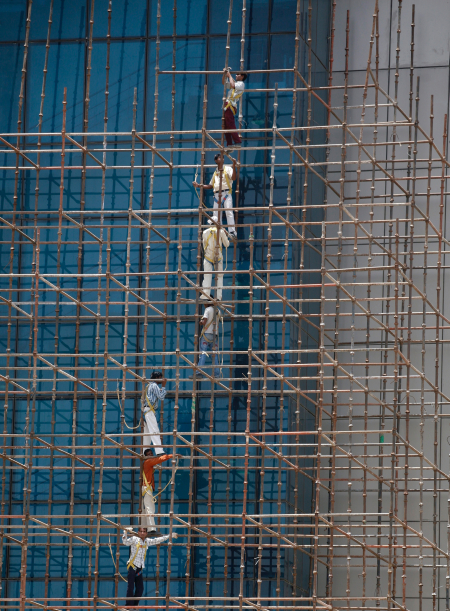 | « Back to article | Print this article |
'UP is one of the five fastest growing states in India'
"UP's fiscal story is extraordinary," economist Arvind Mohan tells Sheela Bhatt.
If one has money, he advises, one should invest in Uttar Pradesh. "Your money is likely to grow as UP is set to improve its power sector."Sheela Bhatt continues her series where UPwallahs discuss the mindset of voters, the personalities of its leaders and lives in the election-bound state.
Part I: 'It is likely to be a BSP-BJP government in UP'
Part 2: 'Put your bets on the Samajwadi Party and the Congress'
Dr Arvind Mohan, an associate professor at Lucknow University, has a fresh take on Chief Minister Mayawati's management of Uttar Pradesh's economy.
Dr Mohan is currently a consultant with the World Bank and adjunct faculty at the Indian Institute of Management-Lucknow and faculty for the flagship programme of the University of Texas.
Students from American universities like Harvard, MIT and Columbia University and from educational institutions in the United Kingdom and Australia, who want to understand Uttar Pradesh and its economic programmes, invariably meet Dr Mohan.
In a forceful debate with Rediff.com's Sheela Bhatt at his office in Lucknow University, Dr Mohan expresses his appreciation for Chief Minister Mayawati's management of the state economy.
If one has money, Dr Mohan advises, one should invest in Uttar Pradesh. "Your money is likely to grow as UP is set to improve its power sector," he says.
The first of a two-part interview:
How has UP fared in the economic criteria in the last five years?
When we look at the economic criteria, let us divide it into two parts. One is a fiscal story. UP's fiscal story is extraordinary and let us not confine it to five years only because 1998 was the year in which UP plunged into a crisis.
The dimension of the crisis can be understood by the fact that revenues from state taxes were only Rs 7,000 crore (Rs 70 billion).
The salaries of 16 lakh (1.6 million) employees in UP was Rs 11,000 crore (Rs 110 billion); the state revenue was not even enough to pay their salaries.
The government of UP came out with a white paper stating all these facts. And that is where the story begins.
Thereafter, serious efforts started in UP and in this period which you are looking at -- 1998 to 2012 -- you have seen every possible political combination in UP. There has been the Bharatiya Janata Party, there has been Mulayam Singh Yadav, there has been Mayawati. So, all possible political combinations have ruled UP.
And they have all continued with this correction process, contrary to the perception of people that if a new government comes to power, it will just undo everything that the earlier government did.
Please check out Rediff Realtime News for the latest updates on the Uttar Pradesh election
Please click NEXT to read further...
'UP is one of the finest performing states'
Sheela Bhatt's interview with Dr Arvind Mohan continues:
Here is one story where you find that there has been commitment from the political class and there has been a strong commitment from the bureaucratic class.Before 2004, even if you look at the picture of 2003-2004, on all major indicators, there are at least six major indicators which the 12th Finance Commission has gone into.
If we take those six indicators themselves -- fiscal deficit; revenue deficit; capital expenditure; social sector expenditure; debt -- on every possible indicator, before 2004, amongst the 17 major states of India, UP ranked somewhere at the bottom.
If you look at this picture in 2008-2009 and beyond, you find that this story has completely changed. UP today ranks 2, 3 or 5. Not below 5 on all indicators, but one -- that is debt.
With regards to all remaining indicators, UP is today one of the finest performing states as far as fiscal indicators are concerned. So this is the transformation that we see.
We did a study sometime ago for the World Bank. We tried to capture the picture of all 17 major states.
What were your findings?
UP had taken a lot of debt from the World Bank, which required a lot of interest payment. This meant that several thousand crores were going out to pay interest. But, UP had an advantage, because in the early part of this century, the rate of interest was low. Other than that, there has been significant improvement in fiscal management, particularly in tax mobilisation -- it has improved significantly.
Look at the global picture, the Indian picture in 2008-2009 and beyond. Now this is the period when because of the global meltdown, most countries including India had felt a huge pressure on their finances.
The government of India, in 2008-2009, saw tax collection going down by almost Rs 60,000 crore (Rs 600 billion).
Now this is the period -- despite this kind of slowdown all across India -- when UP recorded 17 per cent growth in taxes. The tax collection continued to improve in UP. This was the biggest story.
Another important factor was that while this correction process was happening, more resources were getting collected at all levels. UP did not compromise on critical expenditure like capital expenditure.
In 1998, from whatever resources UP had out of the total budget, only 6 per cent was given for capital expenditure. That was too low because the UP government's hands were tied and they were not in a position to initiate development or were unable to make social intervention. They had no finances.
Today, the picture has changed completely. The total capital expenditure that UP has will be in the range of over 15 per cent.
So on one hand, the fiscal deficit was being brought down, but it was not brought down by cutting down critical expenditure. In fact, social expenditure has been increased during this period. Now this is a critical transition.
In terms of GDP what you find is that, in 1998-2000, capital expenditure was around 1.3 per cent of the state domestic product. It rose to 9.3 per cent by 2010. Now this is the kind of transition that UP is undergoing.
Please check out Rediff Realtime News for the latest updates on the Uttar Pradesh election
Please click NEXT to read further...
'By the end of 2012, UP would have doubled its power generation capacity'
How is the overall growth rate of UP?
If you look at the story for the last four years, UP's growth rate is in excess of 7 per cent, which makes UP one of the five fastest growing states in India. And this is in sharp contrast to what happened in the 1990s.
During the entire 1990s, UP's growth rate was 4 per cent. So from 4 per cent it jumped to around 7 per cent odd. Many people are not able to appreciate where this growth is coming from, particularly since there was no industrialisation.
Industrialisation has not been the focus of the state government.
My feeling is that two things are happening. One, growth is happening because fiscal correction happened, the state's capacity to invest and spend has gone up and that is making a real difference.
Then, there are sectors like agriculture and few others, which are growing in real terms. Plus, the construction industry is booming, the service sector is rising significantly. I think this is where the growth story of Uttar Pradesh is being written.
Also, the infrastructure sector is getting attention. On March 31, 2009, UP's power generation capacity was 5,500 megawatts. Now, it is already 3,000 MWs more! The chances are by the end of 2012, UP would have added 5,500 mega watts, doubling its generation capacity in three years!
It is a significant improvement, which you can't ignore.
Please check out Rediff Realtime News for the latest updates on the Uttar Pradesh election
Please click NEXT to read further...
'UP's industrial growth is a significant contributor to its GDP'
You are explaining the financial facts. But when you move around in UP, you see the pathetic condition of people living in the villages.
How do you match this 7 per cent growth and the fact that nothing much has moved in many villages?
See, you are talking about a state which houses 20 crore (200 million) people. You are talking about a state which has a history of its own.
From 1950 to 1990, the growth rates were limited. The transition in education and transitions in poverty reduction were extremely limited.
Now you can't expect that the state can be changed in 10, 15 years. It is not possible, it takes time to make a transition.
So, when you are looking at a transition, look at a simple story, say education.
The increase in the literacy rate from 1950 to 1990 was just 12 per cent. And the increase in the literacy rate between 1990 and 1999, in nine years, is 14 per cent. So UP achieved in a decade what it had achieved in the first 40 years.
But naturally, your backlog is so huge that the impact will be felt later. Similarly, the power sector has a long gestation period. You keep on investing, but the results don't come for several years. And then once it comes, it has a spin-off to it.
My feeling is that from 2013 or so, you will have reasonably more power supply in UP. You will feel the impact.
What you are trying to say is that in villages or in towns you are not feeling the impact. That is correct because investments are made in the power sector, but the power is still to be generated or some of it has been just generated.
Now once it becomes available, you will see that industries are thriving; small-scale industries, the agriculture sector, they will all feel the positive impact.
When we are looking at GDP transition, you will find that UP's industrial growth is a significant contributor. It has been growing almost at 10 per cent, but you are not feeling its impact.
Where is this 7 per cent growth of UP coming from? The agriculture sector in UP is fluctuating. A few years, it might have been close to 4 per cent, but not so in most years.
In Uttar Pradesh, growth is coming from the infrastructure industry, which you will feel only gradually. Other real term growth is happening in the real estate sector.
Gradually, you will find growth coming from the small-scale sector or other significant sectors, once the supply of power increases.
Don't miss Part 2 of Sheela Bhatt's fascinating interview with Dr Arvind Mohan!
Please check out Rediff Realtime News for the latest updates on the Uttar Pradesh election
Please click NEXT to see other interesting slide shows...




